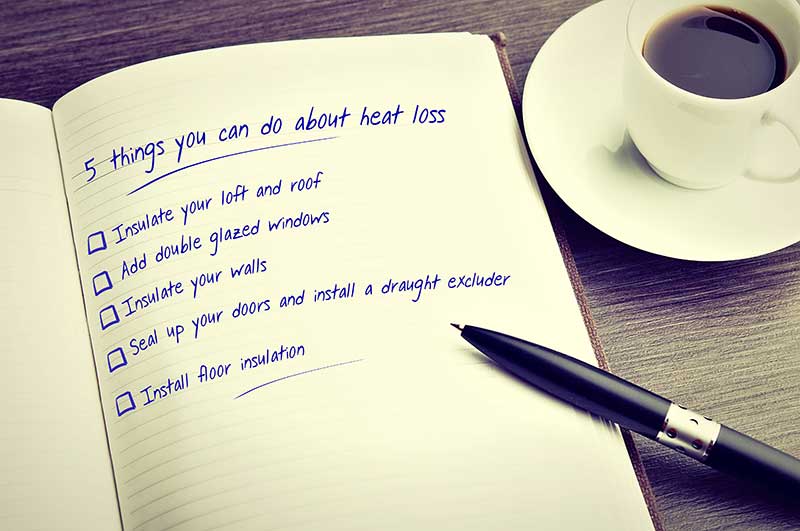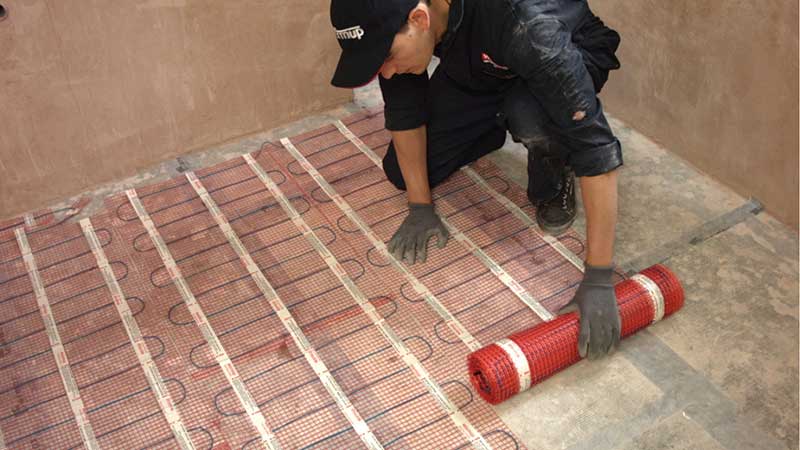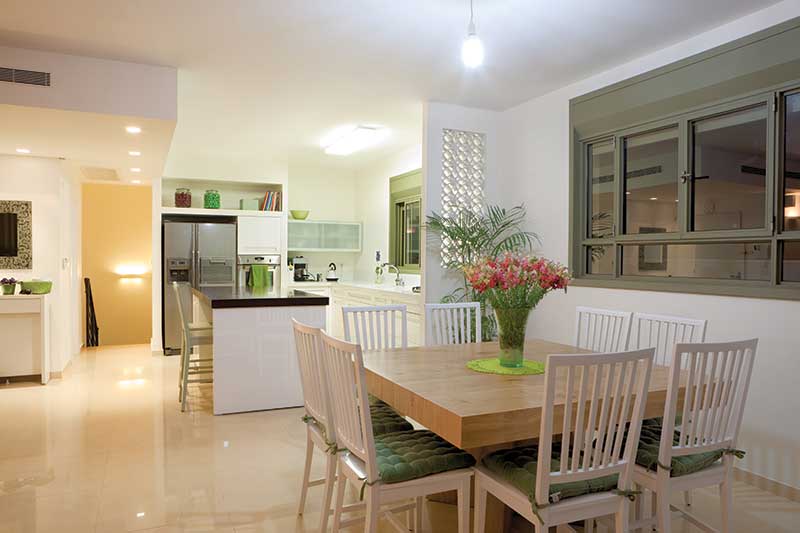Whether you’re looking to buy a new build, refurbish your existing home or just looking to renovate a room in your home, to reduce heat loss is one of the biggest considerations when it comes to making your home warm and cheaper to run. The less heat loss the less heating you will require, which will save energy and money and result in lower heating bills.
WHAT IS HEAT LOSS?
Heat loss is where heat escapes from inside the building to outside, typically through the roof, walls, windows and floor. Knowing the heat loss helps determining the most efficient heating system and ensuring that your property is adequately heated.
When looking at heated floors, knowing the heat loss of your room or home will tell you if underfloor heating will be enough to heat your room or home properly. If the heat loss is low, it is highly likely that floor heating will be enough. But if the heat loss is high, you may need to look at ways to reduce heat loss to ensure efficient performance of the system. Heat loss will also validate whether the building meets regulatory approval and, more significantly, determine the energy requirements and running costs of your home.
WHY REDUCE HEAT LOSS ?
A home with a high heat loss costs you more money, but the good news is that there are few simple steps you can take to reduce the energy loss via heat escaping your home to reduce your heating bills.
Simply put, in order for a heating system to provide enough heat to a room, the system output must be greater than the heat loss.
REDUCE HEAT LOOS AND ENERGY CONSUMPTION
There are several ways to reduce energy consumption and heat loss. These include:
- Improving the insulation of the property (reduction of conduction losses)
- Reducing air leakage (reducing convective losses)
- Reducing energy consumption by using efficient heating methods
If the heat loss is greater than heat output, your heating bills will literally go through the roof as you’re paying more to create more heat in a room. Open doors and windows are one of the most common places for the heat to escape.
REDUCE HEATE LOSS BY IMPROVING THE INSULATION
Improving the insulation of your home is the main way to battle heat loss through floors, walls and windows and roofs. You can either install more insulation or ensure that there are no gaps in the existing insulation as adequate insulation keeps heat loss to a minimum.
1. Insulation of Your Home
For floors, it is important to ensure sufficient insulation between the ground and the floor surface. In new buildings, sufficient insulation is installed during the construction and in older buildings, insulation layers can be laid on existing floor surfaces. Warmup has a variety of floor insulation solutions so if you’re wondering what would be the best type of floor insulation in your property, we can help. Get in touch to talk to one of our experts.
2. Wall, Roof and Loft Insulation
To reduce heat loss from walls, cavity wall insulation can be installed. This involves blowing insulating material into the gap between the brick and the inside wall. Care should be taken to ensure that no gaps are left in the insulation. The use of cavity wall insulation reduces air circulation and therefore minimizes heat loss through walls. Warmup insulation boards can also be used to insulate walls and they work as a great retrofit for wall insulation, adding as little as 10mm to the thickness of the wall.
Cavity wall insulation reduces air circulation and minimises heat loss through walls.
For roofs, the easiest way to prevent heat loss is through insulation of the ceiling in the loft cavity. It is important to put adequate insulation in the loft or ceiling and to ensure that no gaps are left, especially around hatches, electrical and pipework. There’s an easy test for seeing if there are any gaps or leaks. Just take a look at your roof on a frosty morning and if you see any areas without frost, you know that there are some air leaks or insulation gaps as these will show up as areas without frost.
The use of more loft insulation can reduce heat loss by reducing the movement of air upwards. The fibres of the insulation can also prevent the trapped air from circulating and causing convection currents.
If you don’t already have roof or loft insulation, some energy providers offer this for free roof and loft insulation so it’s worth checking with your provider whether your home qualifies as this can save you money on your heating bills. Any cracks or breaches in walls or ceilings (especially around ceiling hatches) or floors should also be filled to reduce heat loss.
Installing roof insulation helps keeping the heat generated in. You may also be eligible for free roof and loft insulation through an energy supplier.
3. Insulating Windows and Doors
To reduce heat loss through windows, the installation of double / triple glazing can significantly reduce any losses. Generally, the gaps between the panes of glass are filled with air. Heat loss is reduced as air is a poor conductor of heat. The use of caulking materials around window and door frames can also reduce heat loss.
Draught excluders around doors can save energy too. These are around £15 and take minutes to install. The typical air leakage from doors is 11% and whereas a gap under the door may seem insignificant, a 1/8 inch gap under a 36 inch wide exterior door will let as much cold air in your home as a 2.4 inch-diameter hole punched in the wall (source: The Washington Post). The installation of a draught excluder is easy and you can do it yourself, making these a great investment when reducing heat loss.
Energy Consumption by Using Efficient Heating Methods
In addition to minimising heat loss, investing in an efficient heating method will also reduce your energy consumption. The lower your heat loss, the less heating you will require and the less it will cost you. The less heating you require, the more likely a comfortable, low temperature underfloor heating system will work for you.
You should also pay attention to opening the windows. Leaving windows open is one of the major sources of heat loss as people usually open the windows then the indoor air feels stuffy or is simply too hot. All this wastes energy and money so getting a heating system that does not overheat makes sense. Underfloor heating provides gentle heat, doesn’t contribute to a stuffy atmosphere so you don’t have to open windows that allow heat and money to escape.
Floor heating is ideal for low heat loss areas where it provides gentle and energy efficient heat, without contributing to a stuffy atmosphere.
Quick Energy-Smart Tips
There are other simple ways to reduce the overall heat loss, including fitting carpets, underlays, and curtains.
The main loss of warm air can be, perhaps surprisingly, through windows and doors which are left open. Ensuring this practice is kept to a minimum can dramatically reduce heat loss. Dampers on open fires to reduce warm air rising up chimneys when they are not in use.
Reducing heat loss is easy and some of these tips, such as installing a draught excluder, can be done in minutes yourself.
Reducing heat loss is easy and some of these tips, such as installing a draught excluder, can be done in minutes yourself.
Learn more in our Underfloor Heating Buying Guide.





![Which Underfloor Heating Is Best for Me? [Flowchart]](https://www.warmup.com/wp-content/uploads/underfloor-heating-flow-chart-thumb-300x199-1.jpg)

![Thumbnail [200x250]](/wp-content/uploads/Indoor-Systems-Page-Image.png)
![Thumbnail [200x250]](/wp-content/uploads/image-13.png)
![Thumbnail [200x250]](/wp-content/uploads/Projects-Image.png)